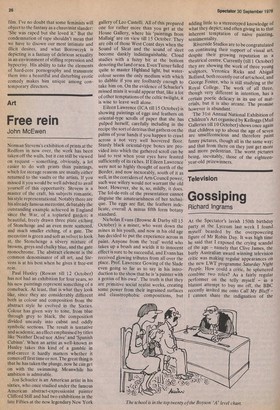Art
Free rein
John McEwen
Norman Stevens's exhibition of prints at the Redfern in now over, the work has been taken off the walls, but it can still be viewed on request — something, obviously, a lot easier to do with prints than paintings, which for storage reasons are usually either returned to the vaults or the artists. If you missed it you would be well advised to avail yourself of this opportunity. Stevens is a master of the craft, his subjects romantic, his style representational. Notably there are his already famous mezzotint, debatably the outstanding example. achieved in England since the War, of a topiaried garden; a beautiful, freely drawn three plate etching of Stonehenge and an even more scattered, and Much smaller etching, of a gate. The mezzotint is green and soft as velvet to look at, the Stonehenge a silvery mixture of browns, greys and chalky blue, and the gate monochrome. The abstract element is the common denominator of all art, and Stevens is at his best when he gives it free-est rein.
Paul Huxley (Rowan till 12 October) has not had an exhibition for four years, so his new paintings represent something of a comeback. At least, that is what they look like, since they are considerably different both in colour and composition from the abstract style he evolved in the Sixties. Colour has given way to tone, from blue through grey to black, the composition divided uneasily into cubist and oddly symbolic sections. The result is tentative and academic, an effect emphasised by titles like 'Neither Dead'nor Alive' and 'Spanish Cubism'. When an artist as well-known as Huxley takes this kind of a gamble in mid-career it hardly matters whether it comes off first time or not. The great thing is that he has taken the plunge, now he can get on with the swimming. Meanwhile his ambition is admirable.
Jon Schueler is an American artist in his sixties, who once studied under the famous American abstract-expressionist painter Clifford Still and had two exhibitions in the late Fifties at the now legendary New York gallery of Leo Castelli. All of this prepared one for rather more than you get at the House Gallery, where his 'paintings from Mallaig' are on view till 15 October. They are oils of those West Coast days when the Sound of Sleat and the sound. of sleet become dankly indistinguishable. Cloud studies with a fuzzy bit at the bottom denoting the land or sea. Even Turner failed quite to master Highland light, but watercolour seems the only medium with which to dabble if you are foolhardy enough to take him on. On the evidence of Schueler's missed mists it would appear that, like a lot • of other temptations of the celtic twilight, it is wise to leave well alone.
Eileen Lawrence (ICA till 15 October) is showing paintings of eggs and feathers on oriental-type scrolls of paper that she has pulped herself, carefully including in the recipe the sort of detritus that gathers on the palms of your hands if you happen to crawl across a not very well hoovered floor. Sturdy black oriental-type boxes are provided into which the gathered scroll can be laid to rest when your eyes have feasted sufficiently of its riches. If Eileen Lawrence were not so highly thought of north of the Border, and now inexorably, south of it as well, in the corridors of Arts Council power, such wee wifery would not warrant the old boot. However, she is, so, mildly, it does. The fol-de-rols of the presentation cannot disguise the amateurishness of her technique. The eggs are flat, the feathers indelicate, overall A minus fifth form botany standard.
Nicholas Evans (Browse & Darby till 15 October) is a miner, who went down the mines in his youth, and now in his old age has decided to put the experience across in paint. Anyone from the 'real' world who takes up a brush and wields it to innocent effect is sure to be successful, and Evans has received glowing tributes from all over the place. Prof. Lawrence Gowing of the Slade even going so far as to say in his introduction to the show that he is 'a painter with a genius of his own'. The truth is that they are primitive social realist works, creating some power from their ingrained surfaces and claustrophobic compositions, but adding little to a stereotyped knowledge of what they depict; and often giving in to that inherent temptation of naive painting, sentimentality.
are to be congratulated on continuing their support of visual art, despite their growing reputation as a theatrical centre. Currently (till 1 October) they are showing the work of three young sculptors, Veronica Ricks and Abigail Bolland, both recently out of art school, and George Foster, who is still studying at the Royal College. The work of all three, though very different in intention, has a certain poetic. delicacy in its use of materials, but it is also arcane. The promise however is abundant.
The 31st Annual National Exhibition of Children's Art organised by Kelloggs (Mail Galleries till 10 October) shows once again that children up to about the age of seven are unselfconscious and therefore paint funny pictures, though all in the same way; and that from there on they just get more and more pedestrian. The worst pictures being, inevitably, those of the eighteen' year-old prizewinners.


































 Previous page
Previous page